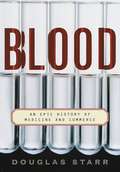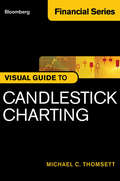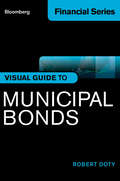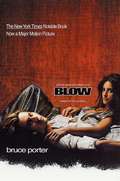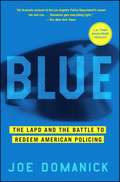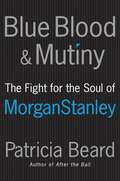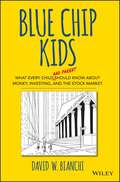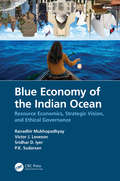- Table View
- List View
Blood on Their Hands: How Greedy Companies, Inept Bureaucracy, and Bad Science Killed Thousands of Hemophiliacs
by Eric Weinberg Donna ShawA few short years after HIV first entered the world blood supply in the late 1970s and early 1980s, over half the hemophiliacs in the United States were infected with the virus. But this was far more than just an unforeseeable public health disaster. Negligent doctors, government regulators, and Big Pharma all had a hand in this devastating epidemic. Blood on Their Hands is an inspiring, firsthand account of the legal battles fought on behalf of hemophiliacs who were unwittingly infected with tainted blood. As part of the team behind the key class action litigation filed by the infected, young New Jersey lawyer Eric Weinberg was faced with a daunting task: to prove the negligence of a powerful, well-connected global industry worth billions. Weinberg and journalist Donna Shaw tell the dramatic story of how idealistic attorneys and their heroic, mortally-ill clients fought to achieve justice and prevent further infections. A stunning exposé of one of the American medical system’s most shameful debacles, Blood on Their Hands is a rousing reminder that, through perseverance, the victims of corporate greed can sometimes achieve great victory.
Blood on the Street: The Sensational Inside Story of How Wall Street Analysts Duped a Generation of Investors
by Charles GasparinoBlood on the Street is a riveting account of the Wall Street scam in which ordinary investors lost literally billions of dollars -- in many cases their life savings -- in one of the greatest deceptions ever, by the crack reporter who broke the original story. In one of the most outrageous examples of dirty dealing in the history of Wall Street, hundreds of millions of dollars in illicit profits were made during the booming 1990s as a result of research analysts issuing positive stock ratings on companies that kicked back investment banking business. Now, for the first time, award-winning journalist Charles Gasparino reveals the whole fascinating story of greed, arrogance, and corruption. It was Gasparino's front-page reporting in The Wall Street Journal that brought the story to national attention and spurred New York State attorney general Eliot Spitzer to launch an official probe. Now, Gasparino goes behind his own headlines to tell the inside story of this spectacular swindle -- with revelations from his unprecedented access to never-before-published depositions and documents, including e-mail exchanges leading all the way up to Citigroup CEO Sanford Weill. Drawing on his research and interviews with industry insiders, Gasparino takes readers into the back rooms of Wall Street's top investment firms and captures the outsize personalities of three key players: Salomon Smith Barney's Jack Grubman, a braggart with one of the largest salaries on Wall Street; Merrill Lynch's Henry Blodget, the Yale graduate who hyped his way to the top of the research pyramid; and Morgan Stanley's Mary Meeker, the "Queen of the Internet," who foresaw the market catastrophe but gave in to the pressures Blood on the Street shows how regulators, like former SEC chairman Arthur Levitt, allowed the deceptive practices to fester and grow during the 1990s bubble, leaving the door open for a then- little-known attorney general from New York State to step in and make his mark by holding Wall Street accountable. Gasparino provides the first major account of Spitzer's rise to prominence, detailing how the attorney general pursued key players to build his case against Wall Street, including his shifting allegiance to the powerful New York Stock Exchange chairman Richard Grasso. A fast-paced narrative rich in sharp insights, Blood on the Street is the definitive book on the financial debacle that affected millions of Americans.
Blood, Sweat, and Pixels: The Triumphant, Turbulent Stories Behind How Video Games Are Made
by Jason SchreierDeveloping video games—hero's journey or fool's errand? The creative and technical logistics that go into building today's hottest games can be more harrowing and complex than the games themselves, often seeming like an endless maze or a bottomless abyss. In Blood, Sweat, and Pixels, Jason Schreier takes readers on a fascinating odyssey behind the scenes of video game development, where the creator may be a team of 600 overworked underdogs or a solitary geek genius. Exploring the artistic challenges, technical impossibilities, marketplace demands, and Donkey Kong-sized monkey wrenches thrown into the works by corporate, Blood, Sweat, and Pixels reveals how bringing any game to completion is more than Sisyphean—it's nothing short of miraculous.Taking some of the most popular, bestselling recent games, Schreier immerses readers in the hellfire of the development process, whether it's RPG studio Bioware's challenge to beat an impossible schedule and overcome countless technical nightmares to build Dragon Age: Inquisition; indie developer Eric Barone's single-handed efforts to grow country-life RPG Stardew Valley from one man's vision into a multi-million-dollar franchise; or Bungie spinning out from their corporate overlords at Microsoft to create Destiny, a brand new universe that they hoped would become as iconic as Star Wars and Lord of the Rings—even as it nearly ripped their studio apart. Documenting the round-the-clock crunches, buggy-eyed burnout, and last-minute saves, Blood, Sweat, and Pixels is a journey through development hell—and ultimately a tribute to the dedicated diehards and unsung heroes who scale mountains of obstacles in their quests to create the best games imaginable.
Blood: An Epic History of Medicine and Commerce
by Douglas StarrEssence and emblem of life--feared, revered, mythologized, and used in magic and medicine from earliest times--human blood is now the center of a huge, secretive, and often dangerous worldwide commerce. It is a commerce whose impact upon humanity rivals that of any other business--millions of lives have been saved by blood and its various derivatives, and tens of thousands of lives have been lost. Douglas Starr tells how this came to be, in a sweeping history that ranges through the centuries. With the dawn of science, blood came to be seen as a component of human anatomy, capable of being isolated, studied, used. Starr describes the first documented transfusion: In the seventeenth century, one of Louis XIV's court physicians transfers the blood of a calf into a madman to "cure" him. At the turn of the twentieth century a young researcher in Vienna identifies the basic blood groups, taking the first step toward successful transfusion. Then a New York doctor finds a way to stop blood from clotting, thereby making all transfusion possible.In the 1930s, a Russian physician, in grisly improvisation, successfully uses cadaver blood to help living patients--and realizes that blood can be stored. The first blood bank is soon operating in Chicago. During World War II, researchers, driven by battlefield needs, break down blood into usable components that are more easily stored and transported. This "fractionation" process--accomplished by a Harvard team--produces a host of pharmaceuticals, setting the stage for the global marketplace to come. Plasma, precisely because it can be made into long-lasting drugs, is shipped and traded for profit; today it is a $5 billion business. The author recounts the tragic spread of AIDS through the distribution of contaminated blood products, and describes why and how related scandals have erupted around the world. Finally, he looks at the latest attempts to make artificial blood. Douglas Starr has written a groundbreaking book that tackles a subject of universal and urgent importance and explores the perils and promises that lie ahead.
Bloodbuy
by Michael Norris Richard G. HamermeshIn 2015, Chris Godfrey, founder and CEO of Bloodbuy has to consider the best path to growth for his young company that is attempting to disrupt the blood donation industry.
Bloodsport: When Ruthless Dealmakers, Shrewd Ideologues, And Brawling Lawyers Toppled The Corporate Establishment
by Robert TeitelmanThe epic battle of the fascinating, flawed figures behind America’s deal culture and their fight over who controls and who benefits from the immense wealth of American corporations. Bloodsport is the story of how the mania for corporate deals and mergers all began. The riveting tale of how power lawyers Joe Flom and Marty Lipton, major Wall Street players Felix Rohatyn and Bruce Wasserstein, prominent jurists, and shrewd ideologues in academic garb provided the intellectual firepower, creativity, and energy that drove the corporate elite into a less cozy, Hobbesian world. With total dollar volume in the trillions, the zeal for the deal continues unabated to this day. Underpinning this explosion in mergers and acquisitions--including hostile takeovers--are four questions that radically disrupted corporate ownership in the 1970s, whose force remains undiminished: Are shareholders the sole "owners” of corporations and the legitimate source of power? Should control be exercised by autonomous CEOs or is their assumption of power illegitimate and inefficient? Is the primary purpose of the corporation to generate jobs and create prosperity for the masses and the nation? Or is it simply to maximize the wealth of shareholders? This battle of ideas became the "bloodsport” of American business. It set in motion the deal-making culture that led to the financialization of the economy and it is the backstory to ongoing debates over competitiveness, job losses, inequality, stratospheric executive pay, and who "owns” America’s corporations.
Bloody Bay: Grassroots Policing in Nineteenth-Century San Francisco
by Darren A. RaspaBloody Bay recounts the gritty history of law enforcement in San Francisco. Beginning just before the California gold rush and through the six decades leading up to the twentieth century, a culture of popular justice and grassroots community peacekeeping was fostered. This policing environment was forged in the hinterland mining camps of the 1840s, molded in the 1851 and 1856 civilian vigilante policing movements, refined in the 1877 joint police and civilian Committee of Safety, and perfected by the Chinatown Squad experiment of the late nineteenth century. From the American takeover of California in 1846 during the U.S.–Mexico War to Police Commissioner Jesse B. Cook&’s nationwide law enforcement advisory tour in 1912 and San Francisco&’s debut as the jewel of a new American Pacific world during the Panama Pacific International Exposition in 1915, San Francisco&’s culture of popular justice, its multiethnic environment, and the unique relationships built between informal and formal policing created a more progressive policing environment than anywhere else in the nation. Originally an isolated gold rush boomtown on the margins of a young nation, San Francisco—as illustrated in this untold story—rose to become a model for modern community policing and police professionalism.
Bloody Panico!: or, Whatever Happened to The Tory Party
by Geoffrey WheatcroftA history and obituary for the British conservative partyAs the Tories face the voters at the next General Election. Leading political commentator Geoffrey Wheatcroft argues that the party is not just facing the loss of government but also an existential crisis.The Tory Party has been the most electorally successful party in the history of modern Europe. It has been in power for eighty-five of the past 135 years. In 2019 they won their largest parliamentary majority in more than thirty years. So what went wrong?In Bloody Panico, Geoffrey Wheatcroft charts the collapse of not just the party but its shattering of its very foundations. 2022 will be remembered as the year of two monarchs and three prime ministers, not to mention four chancellors of the exchequer, five education secretaries, and more than thirty resignations from the government.Beyond the pantomine of Boris, Truss and the managerial dullness of Sunak, the fabric of the party is frayed. At long last the Tories' ancient instinct for survival appears to have deserted them, along with any concern for the public good, and the prevailing mode of dissension and vicious feuding. This could see them cast into the political wilderness for decades.
Bloomberg Visual Guide to Candlestick Charting
by Michael C. ThomsettThe easy-to-use guide to interpreting candlestick charts and derivative marketsCandlestick charts are an effective way of visualizing price movements and, due to the increased interest in the complex derivatives market, they are being used more and more widely. A combination of a line-chart and a bar-chart, where each bar represents the range of price movement over a given time interval, candlestick charts are most often used in technical analysis of equity and currency price patterns. A guide to the most used charts, The Bloomberg Visual Guide to Candlestick Charting is arranged in an easy-to-use manner, providing a quick reference for those new to the field.Candlestick charts are formed with the help of the opening, high, low, and closing price of the day--if the opening price is above the closing price then a filled candlestick is drawn, and these charts are visual aids for decision making in forex, stock, commodities, and options trading.Contains alphabetical explanations of over 200 candlestick and related termsIncludes daily charts of 50 companies, and six-month charts for comparative explanations of candlesticks with Western-style technical indicatorsWritten by Michael C. Thomsett, author of over sixty books and hundreds of articles, including the bestselling Getting Started in Bonds, also published by WileyEnhanced eBook editions offer video tutorials, test-yourself quizzes, and full-color/interactive charts and graphs, available for purchase separately.A practical and concise resource for anyone new to this way of representing derivatives, The Bloomberg Visual Guide to Candlestick Charting presents sometimes confusing concepts in a format that is easy to understand and digest.
Bloomberg Visual Guide to Municipal Bonds
by Robert DotyA hands-on visual guide to understanding and investing in an important and consistently safe investment vehicle Bloomberg Visual Guide to Municipal Bonds offers step-by-step guidance to the nature and diversity of municipal securities credit structures. This valuable guide demonstrates the dependability of the overwhelming majority of municipal securities, and points out particular market sectors that may yield greater rewards, but also present greater risks. This book also directs readers to good sources of up-to-date information as well as new market tools, byproducts of recent market enhancements, so as to assist you in making informed investment decisions. Filled with reliable and highly accessible information needed for making sound decisions when investing in municipal securities Author Robert Doty is a noted expert on municipal securities A valuable addition to the new Bloomberg Visual Series Engaging and informative, this reliable resource is an easy-to-use "how to" guide to municipal securities that will help you create more effective investment strategies.
Bloomberg by Bloomberg, Revised and Updated
by Michael R. BloombergMichael Bloomberg rose from middle-class Medford, Massachusetts to become a pioneer of the computer age, mayor of New York, one of the world's most generous philanthropists, and one of America's most respected—and fearless—voices on gun violence, climate change, public health, and other issues. And it all happened after he got fired at the age of 39. This is his story, told in his own words and in his own candid style. After working his way through college and graduating from Harvard Business School, Bloomberg landed on the bottom rung of a Wall Street firm and worked his way up to partner. But in 1981, he was forced out of the firm. With an idea for computerizing financial data, Bloomberg started his own company. And, since personal computers barely existed, he built his own. Specially designed for Wall Street traders and analysts, the Bloomberg Terminal revolutionized the world of finance. Under Bloomberg's leadership, his company grew rapidly, playing David to the Goliaths of finance and media—and making Bloomberg one of the world's wealthiest men. Bloomberg by Bloomberg offers an intimate look at the creative mind and driven personality behind the Bloomberg brand. He describes in vivid detail his early Wall Street career, both the victories and frustrations, including a personal account of what it was like to be fired and given $10 million on the same day. He combines personal stories with penetrating insights into business and technology, while also offering lessons from his unique approach to management. There is no one in business or politics quite like him—or who has had more success in both areas.
Bloomberg: A Billionaire's Ambition
by Chris McNickleExamine the Bipartisan Legacy of a Remarkable Billionaire PoliticianBloomberg: A Billionaire’s Ambition tells the story of how one of America’s most successful entrepreneurs was elected mayor of New York City and what he did with the power he won. Bloomberg’s stunning victory against all odds just weeks after the 9/11 terrorist attack left him facing challenges unlike any mayor in history. For the next twelve years, he kept the city safe, managed budgets through fiscal crises, promoted private sector growth, generated jobs, built infrastructure, protected the environment, supported society’s cultural sensibilities, and achieved dramatic improvements in public health. Bloomberg was an activist executive who used government assets boldly and wisely for the greatest good, for the greatest number of people. His time as mayor was not without controversy. Bloomberg supported stop and frisk police tactics that a judge ruled unconstitutional, and jailhouse violence rose to levels so severe the federal government intervened. The administration’s homeless policies were ineffective. And he forced a change in the city charter to allow him to serve a third term. Overall, record low crime and the lasting impact of innovative policies will cause his tenure to be remembered as a remarkable success. Having returned to his global media empire, and to his private philanthropy, Bloomberg continues to challenge the National Rifle Association on gun control, promote national education reform, and support policies to combat climate change. Frequently touted as an independent candidate for president, Bloomberg leaves behind a legacy of effective government.
Blow: How a Small-Town Boy Made $100 Million with the Medellin Cocaine Cartel and Lost It All
by Bruce PorterBLOW is the unlikely story of George Jung's roller coaster ride from middle-class high school football hero to the heart of Pable Escobar's Medellin cartel-- the largest importer of the United States cocaine supply in the 1980s. Jung's early business of flying marijuana into the United States from the mountains of Mexico took a dramatic turn when he met Carlos Lehder, a young Colombian car thief with connections to the then newly born cocaine operation in his native land. Together they created anew model for selling cocaine, turning a drug used primarily by the entertainment elite into a massive and unimaginably lucrative enterprise-- one whose earnings, if legal, would have ranked the cocaine business as the sixth largest private enterprise in the Fortune 500. The ride came to a screeching halt when DEA agents and Florida police busted Jung with three hundred kilos of coke, effectively unraveling his fortune. But George wasn't about to go down alone. He planned to bring down with him one of the biggest cartel figures ever caught. With a riveting insider account of the lurid world of international drug smuggling and a super-charged drama of one man's meteoric rise and desperate fall, Bruce Porter chronicles Jung's life using unprecedented eyewitness sources in this critically acclaimed true crime classic.
Blowing My Way to the Top: How to Break the Rules, Find Your Purpose, and Create the Life and Career You Deserve
by Jen AtkinFrom entrepreneur and celebrity hairstylist Jen Atkin comes a smart and spirited guide to finding your voice and creating the life and career you deserve—along with a behind-the-scenes look into Jen’s own wild and wonderful road to success.Hailed by the New York Times as “the most influential hair stylist in the world,” Jen Atkin is a celebrated businesswoman, influencer, and stylist and friend to A-list celebrities like the Kardashian-Jenners and Chrissy Teigen. But Jen’s success didn’t arrive overnight. Her glamorous, jet-setting lifestyle came from years of hard work, humility, and hustle. In Blowing My Way to the Top, Jen shatters the illusion of effortless, instant success that permeates social media to reveal the sweat, dedication, and drive it really takes to make it.In this inspiring, insightful, and laugh-out-loud funny book, Jen chronicles her remarkable journey and shares what she’s learned along the way. From growing up in a conservative Mormon community where girls were discouraged from pursuing their ambitions, to striking out on her own and finding success on the celebrity style circuit, to building the cult-status brand OUAI—Jen reveals with refreshing candor the lessons, mistakes, and memorable moments that have paved her road to success.Jen also offers insight into the values that have allowed her to thrive in the modern, digital landscape, including the importance of creating authentic content, investing in community, and building social conscious into the ethos of a business. And as a trailblazer in a male-dominated industry, Jen speaks frankly about the challenges she’s faced and provides crucial advice for other women, from the importance of running your business like a feminist to building camaraderie amid the competition to learning to navigate the work and life issues that impact women most.At the end of the day, Jen has one simple message: If I can do it, you can too. Blowing My Way to the Top is destined to become the must-read career guide for a new generation, empowering readers everywhere with the permission to dream big—and the tools to make those dreams a reality.
Blowing Smoke: The Fed's Evolving Communication Strategy
by Ethan S. HarrisIn the past, central bank communication could be described as "blowing smoke": the bankers were purposefully ambiguous about their policy actions and economic forecasts. Starting in the late 1980s, however, a decline in political attacks on central banks made it easier for central bankers to be open about what they were attempting to do. Open communication with the public encouraged greater trust in the central bank.
Blue
by Joe DomanickAn award-winning investigative reporter reveals the troubled history of the LAPD in a gripping story filled with hard-boiled, real-life characters that bring to life the ravages of the criminal justice system.Vividly drawn and character-driven, Blue is simultaneously a drama of cops, crime and politics, and a primer on American police policy and reform. Using the LAPD as the book's spine and through-line, Domanick illuminates urban policing at a crossroads during the tumultuous violence-plagued years of the early 1990s. Years when the beating of Rodney King and the LAPD's brutality sparked the 1992 Los Angeles Riots, and police departments were caught between an often brutal, corrupt and racist past, and the demands of a rapidly changing urban population and environment. From LA he then zooms to New York City, and details how the transformation of the NYPD that resulted in a dramatic decrease in crime--even while the LAPD remained in freefall for a decade more before it too begins its road to reformation. Blue ends in the summer of 2014 with crime at record lows, but events in LA, NYC and Ferguson, Mo., raising alarming warnings about aggressive racial profiling and the militarization of American policing. Filled with political intrigue and cultural and racial conflict, Domanick's fast-paced account distills this history through the vivid characters that shaped it, from America's premiere police reformer, William J. Bratton; to Daryl Francis Gates, Chief of the LAPD during fourteen of the most tumultuous years in LA's history; to Charlie Beck, a street-hardened LAPD cop who later becomes Bratton's protégé; to Alfred Lomas and Andre Christian, former members of two of LA's most fearsome gangs, who represent the other side of the LAPD's war on crime.
Blue Blood
by Edward ConlonEdward Conlon's Blue Blood is an ambitious and extraordinary work of nonfiction about what it means to protect, to serve, and to defend among the ranks of New York's finest. This is an anecdotal history of New York as experienced through its police force, and depicts a portrait of the teeming street life of the city in all its horror and splendor. It is a story about police politics, fathers and sons, partners who become brothers, old ghosts and undying legacies.
Blue Blood & Mutiny: The Fight for the Soul of Morgan Stanley
by Patricia BeardThe behind the scenes story of the power struggle that rocked Wall Street's most prestigious financial institution.In March 2005 the business world woke up to an unprecedented full-page ad in the Wall Street Journal calling for the removal of Morgan Stanley's CEO. It was paid for by a cohort of eight former Morgan Stanley executives, including an ex-chairman and an ex-president, who soon would be dubbed the “Eight Grumpy Old Men.” Their target was CEO Philip Purcell, who had come to power following Morgan Stanley's 1997 merger with Dean Witter Discover. In his eight years as CEO, Purcell had presided over a 50 percent decline in stock price since its peak in 2000 and a series of high-profile government and civil lawsuits that had tarnished the company's once-sterling reputation. Just a few months after the Journal ad, Purcell would retire under pressure, and former president John Mack, who had been pushed out by Purcell, was appointed CEO. The “Eight Grumpy Old Men” won the battle.Opening the long-closed doors of a bastion of Wall Street that has maintained the strictest privacy until now, Blue Blood and Mutiny is real-life business thriller exposing the tale that shook high finance. Weaving the history of Morgan Stanley with the inside story of the fight for dominance between two competing business cultures—one, the collegial meritocracy handed down from the days of J. P. Morgan, and the other, a cold, contemporary corporate model, acclaimed journalist and historian Patricia Beard has written a must-read book for anyone who wants to understand the future of American business.
Blue Blood and Mutiny
by Patricia BeardIn March 2005 the business world woke up to an unprecedented full-page ad in the Wall Street Journal calling for the removal of Morgan Stanley's CEO. Less than four months later, a group of eight retired, multimillionaire executives had orchestrated a stunning revolt within the most prestigious and--until recently--most successful financial-services firm on Wall Street. Now acclaimed journalist and historian Patricia Beard brings together the entire behind-the-scenes story, exposing the tale that shook high finance. This riveting real-life thriller is a must-read book for anyone who wants to understand the past, present, and future of American business.
Blue Chip Kids
by David W. BianchiThe essential guide to being smart about money and investing Blue Chip Kids: What Every Child (and Parent) Should Know About Money, Investing, and the Stock Market is a fun and easy-to-understand introduction to the world of money and investing for kids and parents. Frustrated by the lack of entertaining financial teaching materials for his 13-year-old son, this book is the result of a father's commitment to pass on one of life's most important skills. Written by David W. Bianchi--an investor and lawyer with an economics degree from Tufts University--this hands-on resource demystifies the basic principles about money matters and shows what it takes to spend, save, and invest wisely. Filled with simple examples and numerous illustrations, this easy-to-read book discusses money and investing in 100 bite-size topics. For every parent who wants their children to develop the skills to invest wisely and become responsible money managers, regular savers, and to earn money while they sleep, this book is a must-have.ile they sleep, this book is a must-have.
Blue Dreams: The Science and the Story of the Drugs that Changed Our Minds
by Lauren SlaterA groundbreaking and revelatory history of psychotropic drugs, from "a thoroughly exhilarating and entertaining writer" (Washington Post). Although one in five Americans now takes at least one psychotropic drug, the fact remains that nearly seventy years after doctors first began prescribing them, not even their creators understand exactly how or why these drugs work--or don't work--on what ails our brains. Blue Dreams offers the explosive story of the discovery and development of psychiatric medications, as well as the science and the people behind their invention, told by a riveting writer and psychologist who shares her own experience with the highs and lows of psychiatric drugs. Lauren Slater's revelatory account charts psychiatry's journey from its earliest drugs, Thorazine and lithium, up through Prozac and other major antidepressants of the present. Blue Dreams also chronicles experimental treatments involving Ecstasy, magic mushrooms, the most cutting-edge memory drugs, placebos, and even neural implants. In her thorough analysis of each treatment, Slater asks three fundamental questions: how was the drug born, how does it work (or fail to work), and what does it reveal about the ailments it is meant to treat?Fearlessly weaving her own intimate experiences into comprehensive and wide-ranging research, Slater narrates a personal history of psychiatry itself. In the process, her powerful and groundbreaking exploration casts modern psychiatry's ubiquitous wonder drugs in a new light, revealing their ability to heal us or hurt us, and proving an indispensable resource not only for those with a psychotropic prescription but for anyone who hopes to understand the limits of what we know about the human brain and the possibilities for future treatments.
Blue Economy and Smart Sea Transport Systems: Maritime Security (SpringerBriefs in Geography)
by Adolf K. Ng Girish Chandrakant GujarFocusing on maritime security, this book discusses Blue Economy and Smart sea transport systems in the context of the Indian Ocean rim countries and the multifaceted challenges that they are likely to face while attempting to develop such systems. It introduces Blue Economy as a concept with an emphasis on lower costs, reduced waste, greater efficiency, and value addition in all services associated with the near and deep oceans, with the establishment of Smart sea transport systems as the adaptive response in a global trade system. It highlights the roles of maritime security in politics, economics, and environmental management issues that constitute the challenges of achieving such goals. In this regard, the authors approach the issues from the institutional perspective to examine ways in which relevant transport and supply chain stakeholders can collaborate to build secure, resilient global systems of maritime trade. This book will be of interest to anyone interested in marine policy and global supply chains, especially in maritime security, its impacts and risks on transport and supply chain infrastructures, and the related socioeconomic activities likely to be affected. Readers will gain insight into the effective ways to adapt to such risks and how to benefit from the generated opportunities on transport, supply chains, and the global economy. Also, it is an ideal companion to policymakers and practitioners who are eager to learn about the dynamics between maritime security and Blue Economy which, in turn, enhances the quality of strategic planning, policies, and practices in addressing these issues. Finally, it inspires researchers and postgraduate students to conduct innovative research on this topic.
Blue Economy of the Indian Ocean: Resource Economics, Strategic Vision, and Ethical Governance
by Ranadhir Mukhopadhyay Victor J. Loveson Sridhar D. Iyer P.K. SudarsanThe economic paradigms currently dominating the world are not sustainable. The threats from climate change, exploitation-based approaches to commerce, and the excess acquisition of resources loom large as well as the possibility of military flare-ups. Maintaining a balance between development and ecosystems, aspirations for growth, and the need for sustainability is a prescient challenge. The Indian Ocean Region (IOR) encompasses some of the poorest countries in the world and those that will bear the brunt of the negative impacts from climate change. This book explores the immense potential of the IOR and how best to maintain sustainable and responsible economic and strategic activities. The combination of science, innovation, and entrepreneurship will create a new blue economy business model, which has the potential to transform society. Based on critical analysis of the model and its practical applications, including risks as well as opportunities, the topics discussed range from food security, energy, and resilience to climate change, trade and investments, and improved maritime connectivity to tourism, poverty alleviation, and socioeconomic growth, encompassing a wide range of interests and expertise. FEATURES Examines the geo-politics, geo-resources, and geo-hazards of the IOR and identifies opportunities and methods to achieve success Covers a detailed assessment of available resources (fisheries, minerals, energy), threats such as pollution (plastic, acoustic, carbon, bio-invasion), geo-politics (maritime security, military invasion), and strategic vision (determining carrying capacity, ethical governance, and responsible ecosystem) of the Indian Ocean Analyzes the economics of the blue economy, the global scenario including the Pacific and Caribbean islands, and the aspect of the Chinese geo-political invasion in the Indian Ocean Inspires entrepreneurs to adopt new ways of creating economic benefits, reducing energy use, and increasing revenue while simultaneously helping the communities involved Discusses the threat and security perspectives of the IOR and the collective responsibility for a sustainable use of resources Crossing a wide range of interests and expertise, this book explores topics and ideas that will be essential to researchers and professionals in marine sciences, economics, business, geography, and political sciences. Graduate students in the same fields as well as any and all organizations that maintain a presence in the IOR will likewise find this book to be a valuable resource.
Blue Economy: An Ocean Science Perspective
by Venugopalan Ittekkot Edward R. Urban Jr.The ocean is a major source of income for many coastal nations, particularly in the developing world. Economic benefits from the ocean in the long-term depend on its wise science and technology-based management. The intersection of science, technology, and economy are most obvious in nations' coastal zones. This book highlights the need for the application of ocean science and technology for best economic outcomes. It gives examples of ocean resources and the threats to them from climate change and other human interventions, as well as provides information on the available ocean research and observation tools to monitor their impact as well as on the related internationally available opportunities for capacity development.



